Prediction of hemorrhagic transformation after recanalization therapy using T2*-permeability magnetic resonance imaging
Abstract
Objective
Predicting hemorrhagic transformation (HT) is critical in the setting of recanalization therapy for acute stroke. Dedicated magnetic resonance imaging (MRI) sequences for detection of increased blood–brain barrier (BBB) permeability recently have been developed. We evaluated the ability of a novel MRI permeability technique to detect baseline derangements predictive of various forms of HT after recanalization therapy.
Methods
We retrospectively analyzed the clinical and pretreatment MRI data on patients undergoing recanalization therapy for acute cerebral ischemia at a university medical center from January 2004 to November 2006. Pretreatment MRI permeability images derived from perfusion source data were compared with posttreatment imaging to evaluate whether baseline BBB permeability derangements may predict HT after recanalization therapy. The use of a novel permeability technique to illustrate BBB derangements was based on the detection of decreased signal intensity at later time points in perfusion MRI acquisition, signifying continued local accumulation of contrast caused by leakage.
Results
Among 32 patients, some degree of HT occurred in 12. Permeability image abnormalities at baseline were present in 7 of 12 patients with HT and none of the 20 patients without HT on follow-up images. The sensitivity of permeability abnormality for parenchymal hematoma was 83%. False-negative findings were noted in five cases, most commonly asymptomatic or minor HT after mechanical clot retrieval.
Interpretation
Permeability images derived from pretreatment perfusion MRI source data may identify patients at risk for HT with high specificity. Our preliminary demonstration of permeability imaging based on standard perfusion data for prediction of hemorrhage merits further study with dedicated MRI BBB permeability acquisitions and multicenter validation. Ann Neurol 2007




